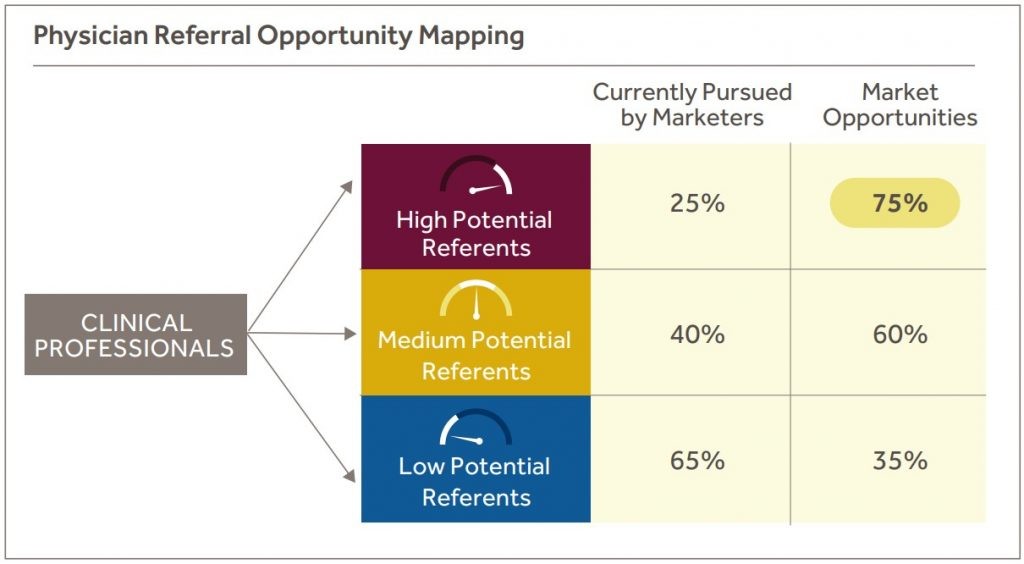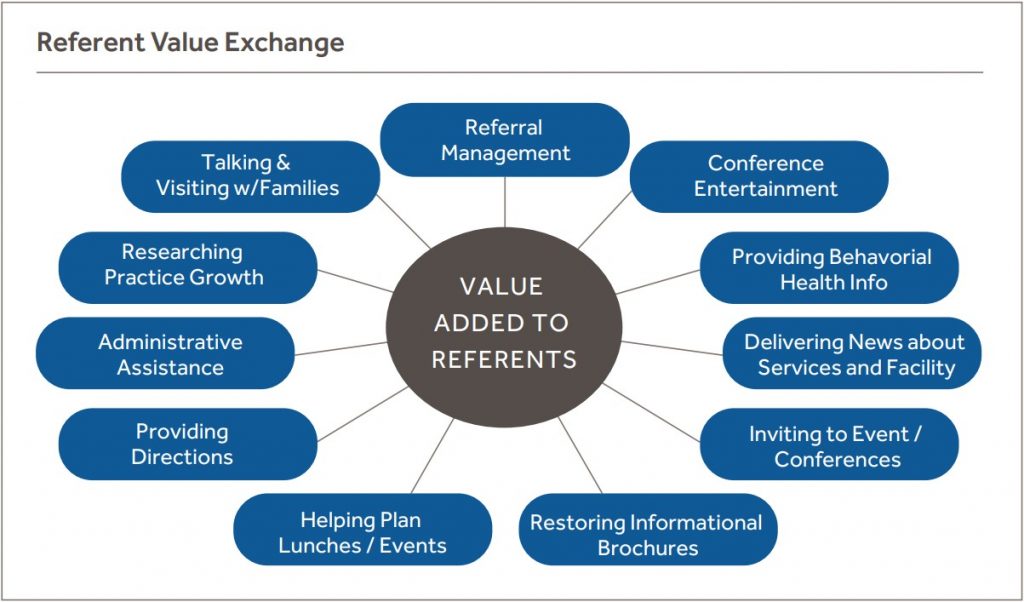Physician Referrals Driving Incremental Growth Through Improved Referral Marketing
Executives at major health care providers know that physicians are key to growing patient volume. Hospitals, outpatient facilities, behavioral health providers and hospice care services have long recognized the importance of physician referrals. In today’s competitive market with more options available to physicians and patients than ever before, these referral relationships have become even more valuable. Providers have always assigned staff to develop and manage the referral programs and activities, such as scheduling dinners, arranging one-on-one meetings, providing referent support, etc., all designed to get and keep patients in the provider’s network. While these traditional approaches have worked in the past, many organizations are finding that the tried and true techniques do not perform nearly as well in today’s challenging healthcare marketplace.
Don’t Overlook the Key Referral Elements
In our work with more than 100 health care providers, we have found that many providers often overlook critical elements required for high-performing physician referral programs. Referral network development seldom receives professional management, such as tailored sales approaches, effective sales management, focused marketing, support tools, information and metrics, and processes that marketing and sales teams in most industries take for granted. Unfortunately, it is not until referrals begin to fall below expectations that the shortcomings of the existing referral efforts come sharply into focus. Executives must then probe for the answers to critical questions:
- Where are the referrals coming from and why?
- Have we properly segmented referral sources to allow for actionable steps to increase volume?
- Are there potential referral sources that are currently overlooked?
- Is there a structured referral development process in place?
- Are there clear expectations for the referral marketing personnel and are clear performance metrics in place?
- Does the referral development team know how to establish and develop strong, long lasting relationships?
- Are the referral marketing strategies and processes adequate to support the growth forecasted in the financial plan?
- How effective is the referral development team and are you satisfied with the “win rate?” Do they know how to create new relationships?
- Are there gaps in the referral marketing team’s skill sets, training, or incentives?
- Is the referral development team right-sized for the opportunity? Are they deployed efficiently?
- Are the physicians getting the support and value they need?
Failure to clearly address these questions will lead to losing significant referral opportunities and lower revenues. In our experience, moving an organization to a high-performance level in referral marketing usually requires more than a few tweaks. Successfully re-energizing a referral network requires fresh thinking grounded in a factual understanding of the current and potential physician referrers.
Understand the Physician Segments
Our work with physician referral networks has shown that the classic concept of market segmentation also applies to physicians. With a detailed understanding of key physician characteristics – such as patient base, likelihood to refer, the current share of referrals, clinical specialty/sub-specialty, and services valued by referents – the referral development team can begin to target differentiated messages to specific physician segments. For example, an orthopedic surgeon with a high volume, an attractive base of patients, and correspondingly high referrals, need to receive consistent messaging aimed at maintaining the share of referrals. Those physicians with lower levels of referrals need a different set of messages and marketing contacts to encourage a change in referral habits, as do those who are not currently part of the referral network.
Prioritization and Time Allocation
Frequently we find that referral development teams are great with the high-value referents “I have lunch with Dr. Jones every Tuesday…” But growth often comes from moving those physicians who split their referrals up to the level of a consistent referral source, as well as expanding the breadth of the overall referral network. Quite often the referral development teams do not have the information that provides insights as to where they should spend their time to find the next most likely referral. Even if the information is at hand, referral marketing teams can find it challenging to shift their time allocation to new more attractive segments of physicians. As they say, old habits are difficult to change.
Our Approach
In our approach, we start with a basic understanding of local market referral opportunities that includes detailed interviews with physicians and other referral sources, as well as an analysis of overall referral performance. Once we understand the potential market we evaluate a company’s current referral marketing approach, capabilities, tools, and processes relative to best practices. Lastly, working closely with our clients, we develop a clear plan of action that maximizes the potential of referral sources in a given market. There are five unique aspects of our approach to helping providers build powerful referral marketing capabilities.
- External View of the Market – Conduct detailed interviews with current and potential physician referents and other referral sources to identify the market potential.
- Referent Scoring Model – Complete an assessment of physician referral potential based on a scoring model including such factors as:
• Specialty
• Patient mix – condition, age, etc.
• Patient volume per week
• Insurance acceptance
• Private pay rates
• Geographic location - Opportunity Mapping – Determine specific opportunities for incremental referrals by key physician segments and geographies, identifying gaps in coverage, effectiveness, and processes, as well as potential economic value.
- Performance Against High Performing Behaviors – Identify the specific behaviors exhibited by the best referral marketers (best practices) and evaluate the organization and individual performance relative to these high-value activities.
- Roadmap and Dashboard to Guide Implementation – Define the new referral development approaches, processes, tools, and organization required through the development of a roadmap to drive execution and measure performance against goals.

The Tools We Use
For most of our clients, once they realize referral marketing is underperforming, they need to move quickly to get back on a growth trajectory. To help them rapidly improve referral marketing we use five of our proprietary tools:
- The Nine Voices of the Market® – Assessment of a provider’s referral opportunity and to identify areas for improvement based on in-depth interviews with physicians and other key referents.
- Characteristics of High Performing Referral Marketers – Analysis of current referral marketing capabilities and approaches against the key characteristics of high-performing referral marketers and identification of gaps.
- Intake Best Practices – Best practices for referral intake and management, including specific behaviors and processes to ensure maximum conversion rates of all referrals.
- Referent Value Exchange – Identification and scoring of the specific value that can be delivered to a referent through specialized support and services.

- Waves of Change – Structured change management approach that prioritizes high-value initiatives in stages or waves to ensure smooth implementation.
With these tools and approaches, providers can identify new high-potential referral opportunities and ensure that they have the processes, skills, and capabilities to build the networks and relationships to achieve their referral goals.
We are experts in helping providers drive revenue growth through better referral networks. Contact us if you would like assistance in identifying opportunities to increase valuable referrals and develop sales and marketing processes to capture those opportunities.


